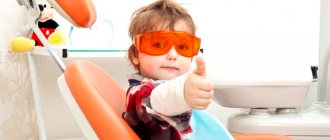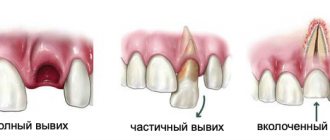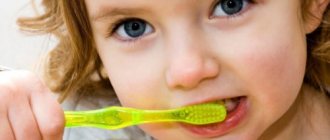The replacement of baby teeth with permanent ones is a natural physiological process that every child experiences. It usually begins in preschool age and proceeds without difficulty. But parents need to approach it responsibly, since any violations when changing teeth are fraught with unpleasant consequences. This may be the formation of a malocclusion, uneven teeth, or the occurrence of a diastema (interdental gap).
In this article we will consider the correct sequence of tooth replacement, possible violations, and situations when consultation with a pediatric dentist is necessary.
Why and when do baby teeth change?
As the child grows, the dentofacial apparatus also develops. At approximately 4–6 years of age, the preparatory stage begins, during which interdental spaces appear. This prepares the place for permanent teeth in the primary dentition.
The process of replacing baby teeth with permanent teeth is a slow process, taking approximately 6 or 7 years (until adolescence). Active growth of the roots of permanent teeth activates the process of bone resorption - this is the destruction (dissolution) of milk roots, which leads to loosening and tooth loss. Standard diagram of the sequence of changing baby teeth in a child.
- Central lower incisors (5–7 years). They fall out one by one with a short time interval.
- Lateral incisors (7–8 years).
- First molars on the upper jaw, second molars on the lower jaw (9–11 years)
- Cone-shaped teeth (canines) at the age of 9–12 years.
- Second molars on the upper jaw and first molars on the lower jaw (10–13 years)
Not everyone's third molars (wisdom teeth) erupt. This is considered the norm. Most often, the optimal age for them is considered to be from 17 to 25 years.
Reference!
The later the first teeth erupted in infancy, the later they will be replaced in preschool age.
By the age of 15–16, a teenager’s permanent bite should number 28 units.
Bookmarking teeth
The formation of baby teeth occurs at approximately 4-6 weeks of fetal development. At the same time, the formation of the fundamental elements occurs much later - during the first months of the child’s life. For this reason, new mothers who are bottle-feeding are strongly recommended to supplement their baby’s diet with calcium. This substance promotes the proper formation of tooth enamel.
At an early age, unprotected baby teeth are extremely susceptible to carious lesions. Parents should monitor this closely, as infection can subsequently cause destruction of permanent teeth. The fact is that the rudiments of permanent teeth are in close proximity to the roots of milk teeth, so as soon as you discover dark spots on your child’s enamel, immediately go to pediatric dentistry.
What deviations from the norm may there be?
Each child develops individually. Sometimes the timing of the replacement of certain teeth may differ from the generally accepted norm. Minor deviations are allowed up to 12 months. But sometimes the change in the primary bite begins too early or, on the contrary, the temporary teeth do not want to fall out.
Causes:
- long-term breastfeeding;
- severe infectious diseases in infancy;
- pathologies of intrauterine development.
Reference!
Dentists believe that a safer deviation is a late change in the primary occlusion than vice versa.
Let us consider in detail the common violations and their causes.
Early tooth loss
We can talk about such a pathology if a child’s baby teeth begin to fall out before the age of 5. Possible reasons:
- advanced multiple caries;
- injury;
- gum disease;
- manual loosening of the tooth.
In all these cases, consultation with a pediatric dentist is required.
Important!
Parents should record the time of tooth loss. If after 4 months the permanent tooth does not begin to emerge, then the help of a doctor is required.
In case of early unnatural tooth loss, it is advisable to conduct an X-ray diagnosis. This will help to identify possible damage to the permanent root rudiment in time and begin treatment. Otherwise, the child will need prosthetics in the future.
Late change from primary to permanent occlusion
The deadline for starting the process of changing baby teeth is 8 years. But this is considered a late shift. The disorder may be caused by:
- heredity;
- metabolic disorders;
- infectious diseases suffered in early childhood;
- mental disorders.
If after 8 years a child has not lost a single baby tooth, this is a reason to consult a doctor.
Premature loss
This refers to the loss of baby teeth when the child has not yet reached the age of 6. Causes may include caries, special loosening and mechanical damage. If a tooth falls out long before the molar begins to grow, a space will appear in the oral cavity that will later be occupied by the remaining teeth. Eventually, permanent teeth will begin to erupt unevenly due to lack of space.
If you experience early tooth loss, you should contact an orthodontist. Often today, in such situations, prosthetic technologies are used, the main task of which is to prevent the displacement of other elements of the dentition. This solution helps prevent the development of malocclusion and the appearance of various visual defects.
Reasons for late eruption
Normally, after a baby tooth falls out, it takes 1-2 months for the permanent tooth to erupt. This is the longest period. In most cases, the rudiments of a permanent tooth can already be seen at the site of the lost tooth.
But, if a child’s toothless smile persists for 3 months or more, then this is a cause for concern for parents.
Let's consider why such dental pathology occurs:
- Retention
– a common condition that mainly affects the incisors and canines. They cannot erupt due to dense gums or because they rest against neighboring teeth. There are complete and partial retention. With the full form, a healthy root is visible in the picture, but it is completely under the gum. With partial retention, only part of the crown is visible. In this case, surgical assistance is required.
- Edentia
– a congenital pathology in which there is a lack of rudiments of permanent dental units. Can be complete or partial (sparse teeth). A rare disease. Orthopedic treatment is required as early as possible.
- Impact
– delayed eruption in this pathology is associated with a mechanical obstacle, that is, the child has a supernumerary of dental units. In this case, the permanent root simply does not have room to erupt. Impaction can only be detected using a panoramic x-ray of the jaw.
The sooner the child is examined by a doctor, the higher the chance of having an even and complete dentition.
Why do empty spaces remain unoccupied for a long time?
It often happens that a child walks around with a toothless smile for a long time, but the situation still does not change. When examining his oral cavity, the parents do not see even a hint of an imminent full bite. This happens when:
- Retentions. Dental pathology in which a segment of gum tissue is shown very little or not at all. The violation may be complete or partial. In any case, if it occurs, you should consult your dentist. Sometimes the situation can only be corrected through surgery.
- Edentia. The banal absence of a permanent germ. So, for example, a temporary fang falls out, and there is nothing to replace it with. The anomaly can be confirmed using x-ray diagnostics - the images show that the rudiment is missing. Fortunately, congenital adentia is rarely diagnosed in young patients. If it is, only prosthetics will save you.
- Impacts. Difficulties with eruption with this diagnosis are explained by the fact that the crowns of the “neighbors” are too close to each other and do not leave room for the crown, which should be between them. Deviations can also be detected using x-rays.
If there are any problems with the bite, parents should show the baby to the doctor. Moreover, children should have annual checkups at the dentist's office. This simple measure serves as an excellent prevention of serious complications and reduces the likelihood of an unattractive smile in adulthood.
Possible problems when changing baby teeth
Common dental pathologies when changing a primary dentition to a permanent one include:
- Shark teeth. A phenomenon in which baby and permanent teeth are located parallel to each other, in 2 rows. This arrangement can interfere with the normal development of the dental system. But in most cases, the temporary root becomes loose, and the “extra” tooth falls out on its own. If this does not happen, removal at the doctor's office is recommended.
- Increased pain. Sometimes a change in the milk bite is accompanied by increased body temperature, redness of the gums and severe pain. These symptoms usually accompany early or late change of teeth. Inflammatory diseases of the oral cavity may also be the cause.
- The appearance of a hematoma.
In rare cases, when molars erupt, a hematoma occurs on the gum in the form of a small bubble with an accumulation of blood. This occurs due to severe eruption, which leads to rupture of blood vessels. The gums may be pale in color. Pain and discomfort occurs. If suppuration occurs, medical attention is required.
If pathological phenomena do not go away for a long time, and the child is irritable and complains of pain, be sure to visit the dentist.
Replacement too late
In some cases, the molars are already erupting, although the milk teeth are not yet loose. Often this also leads to the appearance of certain defects. The solution to the problem is to visit a specialist to remove a baby tooth.
It also happens that molars do not appear in the standard time frame. In this case, temporary teeth may be present or fall out. Reasons for this phenomenon:
- Physiological factor. The development of tooth germs occurs properly, but their growth is too slow for certain reasons.
- Retention of molars. The tooth germs are formed in a timely manner, but the location of the permanent tooth inside the jaw bone tissue is incorrect.
- Partial primary adentia. During the development of the child inside the mother's womb, the proper laying of the rudiments did not take place or their death occurred due to inflammation.
To detect such defects and determine the exact reasons for untimely replacement of baby teeth, a specialist uses x-ray examination, which allows us to determine the characteristics of the formation of tooth germs. If developmental defects are detected, children are prescribed temporary prosthetics for the period of active jaw growth. After reaching a certain age, permanent dentures are installed.
What not to do when baby teeth fall out
Incorrect actions of children and parents can lead to the formation of malocclusion, increased pain, or the formation of crooked teeth. To avoid this, it is recommended to adhere to the following rules:
- Don't help baby teeth fall out if they are straight and not loose. Even if, according to the child’s age, it is high time for him to have a toothless smile.
- Don't loosen your teeth with your hands. And do not pull them at home, for example, with a thread.
- Baby teeth are quite fragile in preschool age. Therefore, your child should not indulge in solid foods. The crown may break, but the root will remain in the gum.
- If a tooth falls out, do not allow your child to touch the socket with his tongue or hands. Gentle rinsing with antiseptic solutions or herbal decoctions is recommended.
If you have a fever, cough or lethargy, do not rush to resort to antiviral drugs. Poor health can be a harbinger of the imminent change of baby teeth.
Care instructions
Since the enamel is not yet fully formed during the eruption of molars, great attention should be paid to proper oral hygiene and preventive measures to prevent the development of caries.
- In the morning and evening, teeth should be brushed using a soft brush that does not damage the gums. Children are recommended to use special toothpastes with a high content of calcium and fluoride. It is better to brush your teeth under adult supervision, as children often do it too quickly and not thoroughly enough.
- All children should visit the dentist twice a year for an examination, professional cleaning, and timely detection and treatment of tooth decay.
- After any meal, children should rinse their mouths with plain water, a special baby mouthwash, or chamomile infusion. Thanks to this, plaque will not accumulate on the teeth and the likelihood of developing an inflammatory process in the eruption zone of the molar will decrease.
Tips for parents
During the period of teeth change, you should enrich your baby’s food with foods that are rich in calcium. To prevent inflammation in your mouth, make it a habit to rinse your mouth every time you eat or have a snack. As permanent teeth erupt, offer your baby soft or liquid foods. Avoid hot drinks.
If slight bleeding occurs when a baby tooth falls out, do not use alcohol tinctures. Apply a cotton ball to the wound and do not allow food for 2 hours. In order to promptly identify possible irregularities in the eruption of the permanent dentition, it is recommended to record the date of baby tooth loss.
Beautiful, straight and healthy teeth in adults are the result of proper care in childhood. Therefore, parents should teach their child proper oral hygiene from the first tooth.
Why is it necessary to replace baby teeth with permanent ones?
The chewing apparatus is improving and developing. In infancy, it is adapted exclusively for the intake of liquid food - breast milk. But closer to six months, you can already see baby teeth in children’s mouths. They allow the baby to get acquainted with the variety of solid adult foods.
There are few temporary teeth - ten pieces in each jaw. This is quite enough for the baby to eat well and talk normally. Closer to primary school age, the jaw grows. She is ready to cope with more serious chewing loads. Then children's incisors, canines and molars begin to wobble. They are replaced by a constant shift.
Deadlines
At the age of five, teeth can become mobile. Then the process of loss and growth of new ones begins:
- six to seven years – lower and then upper central incisors;
- seven to eight years - the lateral incisors change;
- eight to ten years – first molars;
- nine to eleven years – fangs;
- eleven to thirteen are second molars.
The correct formation of the jaw depends on many factors: how the pregnancy proceeded, how long the child was breastfed, what infectious diseases were suffered, etc.
Why can a lot of time pass between the loss of baby teeth and the eruption of permanent teeth?
Most often, the front teeth grow quickly. And canines and baby molars (premolars) can be delayed. After a temporary tooth falls out, it may even take 4-6 months until a permanent tooth erupts in that place. Just expect it and take good oral care. But if this period begins to exceed six months, so as not to worry, it is better to visit a doctor. After examining the child, he will be able to decide whether the permanent tooth needs to be stimulated to grow.
What does the dental formula look like?
The medical record, which the big one keeps in the dental clinic at his place of residence, contains notes about his dental condition. To avoid confusion, doctors number the teeth on each side of each jaw. So, the 1st and 2nd teeth are incisors, the 3rd are canines, the 4th and 5th are small molars (doctors call molars molars), the 6th and 7th are large molars. The 8th - the farthest one - is a “wisdom tooth”; a number of people do not have it, or they do, but not all. Each side of the jaw is also numbered: 1 - top right, 2 - top left, 3 - bottom left, 4 - bottom right. For example, entry 48 does not mean that you are a “Tarkatan” with a combat superset of teeth that does not exist. You simply do not have a “wisdom tooth” on the lower right. Entry 41 - a person lost one of the frontal incisors on the same side on the same jaw. You can write down the formula of the teeth more clearly: for example, “there is no 8th tooth from the bottom right.”
It often turns out that due to lack of space on the jaw, the wisdom tooth develops incorrectly - it can grow crooked, in which case its removal is indicated. For example, it may remain under the gum and, because of this, be affected by caries, which can subsequently develop into pulpitis or a dental cyst. Problematic “wisdom teeth” are quickly and decisively removed, and their absence will not greatly affect the quality of chewing food.
How does the growth process of molars occur?
At 12-13 years of age, a child, as a rule, no longer has milk teeth, although their roots dissolve earlier. At this point, there are part of the molars in the mouth with fully and partially formed roots.
Dental roots go through 2 stages in their development:
- the period of unformed apex (the root is still as long as possible, the walls are parallel, the canal is wide);
- the stage of an unclosed apex (the formation of the apex ends, the walls of the canal come closer together).
The roots of the lower jaw form faster than the upper jaw. This process also has approximate deadlines, but they can shift in both directions. Therefore, it is definitely impossible to answer the question at what age children develop permanent teeth - canines, incisors or molars. As with dairy products, everything is individual here.
Role of parents
In most cases, changing primary teeth does not cause any particular difficulties. But if a child complains of discomfort in the gums, you can use gels that have an analgesic effect, for example, Dentinox or Kalgel.
If instead of a baby tooth there is a wound on the gum that is bleeding, you can apply a ball of sterile cotton wool to it and hold it for about 5 minutes. After a temporary tooth falls out, it is forbidden to eat food for 2 hours. On that day, it is better not to give your child spicy, salty or sour foods.
If a molar has already broken through, but the baby tooth has not yet fallen out, it is better to use the help of a dentist rather than remove it yourself.
How teeth erupt
The procedure for teething in infants and adults is the same, with the difference that the teething is more painful. In addition, when the time comes for permanent teeth to appear (at age six), a child can already talk, endure pain, and is not capricious like a baby.
By the way. Sometimes on the gum, before the tooth should appear, a tubercle swells, as if filled with liquid. In fact, this is the gum tissue softening, allowing the tooth germ to emerge to the surface. If the tubercle is large, you can consult a doctor so that he can release the fluid and make eruption easier.
It is not necessary that your baby will feel unwell and pain when teething, but this happens in 2/3 of children, so you should prepare for the appearance of teeth and keep the process under control.
- When baby teeth appear, the temperature may rise, cough, runny nose and other cold symptoms may appear.
- The baby will experience increased salivation during this period.
- He will try to “scratch” the gums to relieve the discomfort.
- There may be signs of intestinal upset, diarrhea, constipation, and loss of appetite.
There's no need to worry. If you have symptoms of teething, you need to stock up on medications that will alleviate the baby’s condition, be patient, and show love and affection.
Temporary
There is a natural order of appearance of teeth, which is determined by nature. By the end of the first year of life, the child should have eight teeth. And by the time he turns three, he’s twenty, forced to change. The rest, which will begin to grow at the age of six, although they are the first, are not going to fall out.
The pattern of appearance of primary teeth is normal.
- The very first to appear, on average at the age of 5-6 months, are the lower incisors, located in the center of the jaw. The latest date for their release is 9 months.
- In the seventh month and up to the tenth month inclusive, the upper central incisors should appear.
- Up to the 13th month, the upper lateral incisors are cut, followed by the lower lateral incisors.
By the way. The pattern of teething in a child under two years old fits into the formula: the number six is subtracted from the child’s age, which is taken in months. The result is the number of teeth that should grow by this period. After two years, tooth growth does not comply with this formula.
Table. Eruption of primary teeth
| Location | Age (in months) |
| Central incisors from below | 6-9 |
| Central incisors from above | 7-10 |
| Lateral incisors from above | 9-13 |
| Lateral incisors from below | 10-16 |
| Premolars at the top | 12-15 |
| Premolars below | 13-17 |
| Fangs above and below | 18-21 |
| Molars above and below | 20-30 |
Anatomy of permanent teeth
The molar tooth includes three zones: the root, which sits deep in the jaw socket and holds the tooth in place, the neck, located in the periodontal area, and the crown, which extends directly into the oral cavity. After the apex of the tooth appears, a protective film forms on the enamel, the strongest layer of the tooth, which is soon replaced by a salivary layer, formed from the saliva itself. The dental tissues themselves are not just a piece of bone, but a certain heterogeneity, which includes, in addition to enamel, dentin (the main substance of the tooth) and the dental cavity, in which nerves and blood vessels branch. Compared to bones, for example, the phalanges of the fingers, dentin is noticeably stronger - it contains an increased amount of minerals, for example, the same calcium-based compounds. The root zone of dentin is connected to the periodontium using a special layer - dental cement, which communicates with the tissues of the periodontium itself and supplies the dentin with nutrients.











